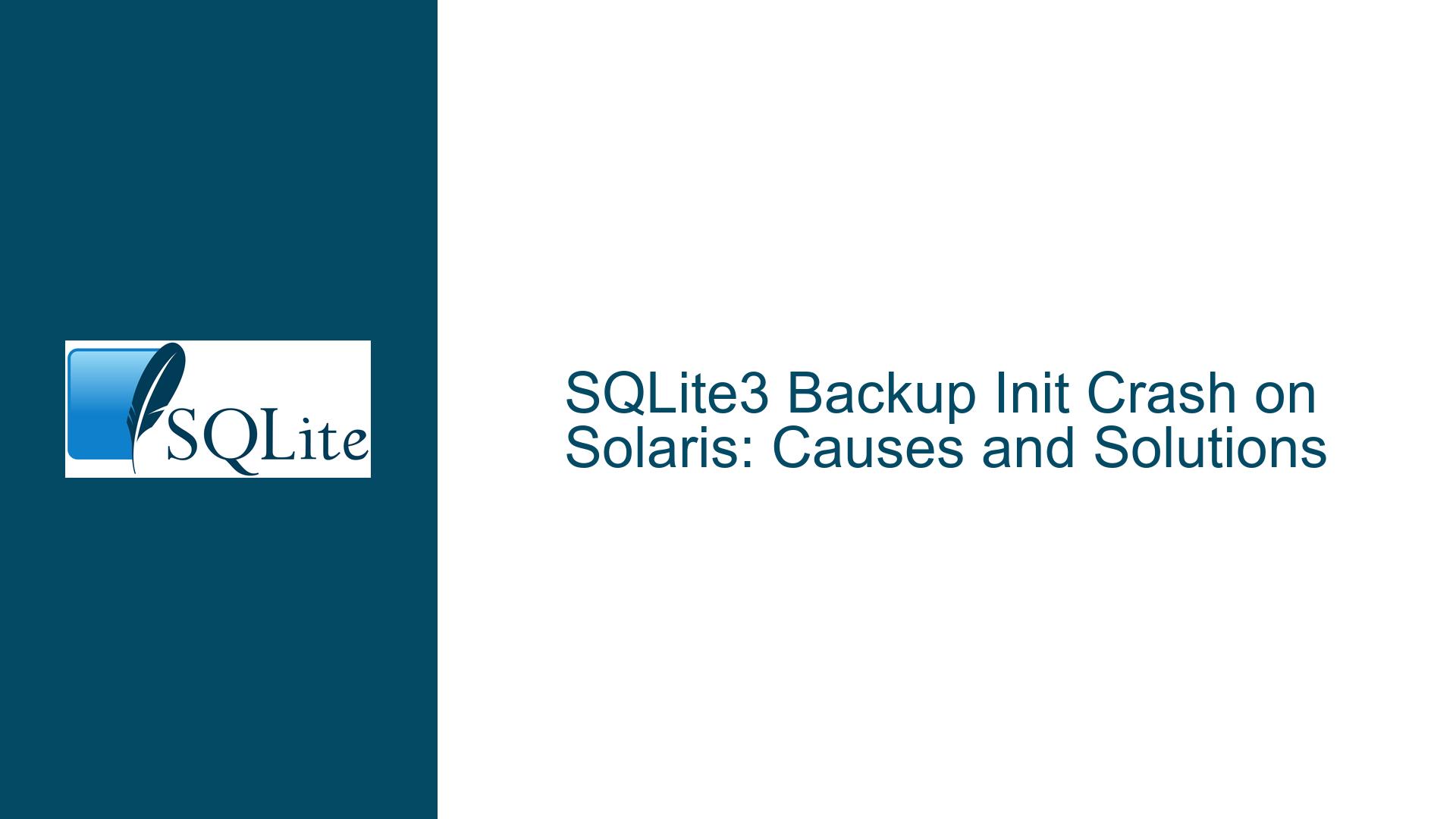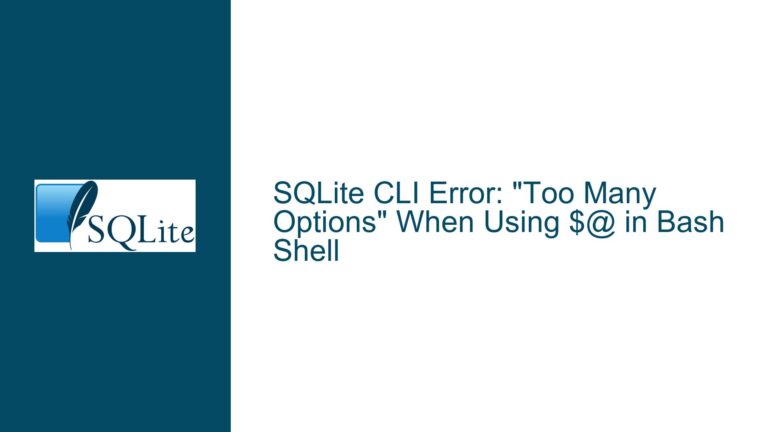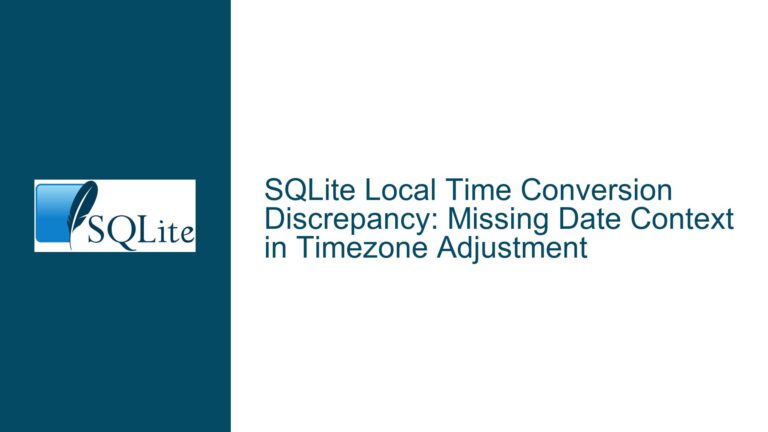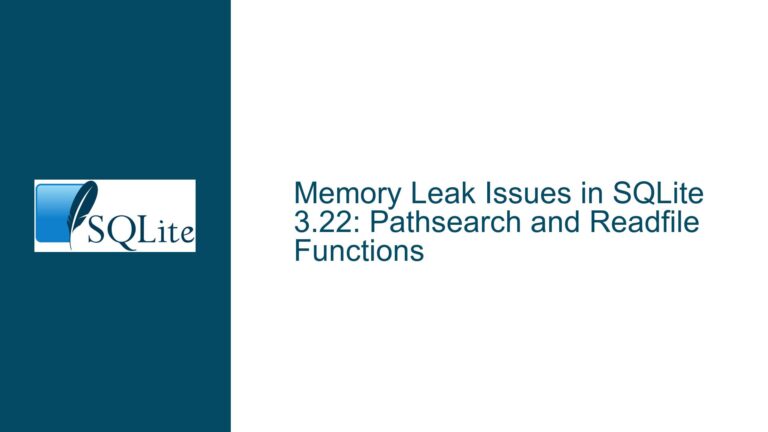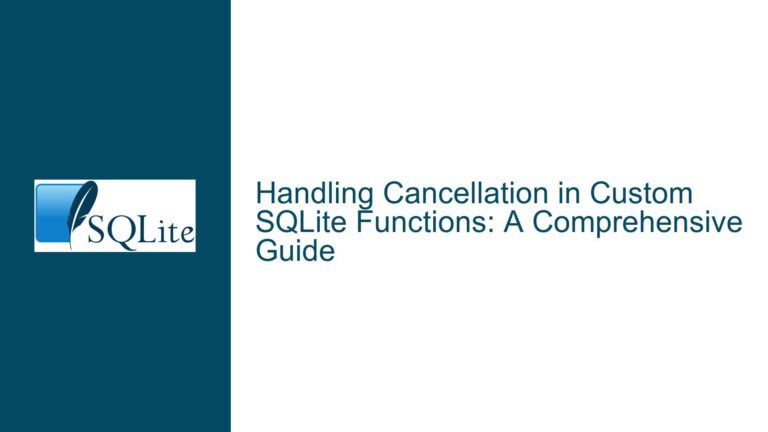SQLite3 Backup Init Crash on Solaris: Causes and Solutions
SQLite3 Backup Init Function Crash on Solaris
The sqlite3_backup_init() function is a critical component of SQLite’s backup API, allowing developers to create in-memory or disk-based backups of SQLite databases. However, when attempting to use this function on Solaris (SunOS 5.10), the application crashes, while the same code works flawlessly on Windows. This issue is particularly perplexing because it persists even after upgrading to the latest SQLite version compiled from the amalgamation source. The crash occurs specifically during the sqlite3_backup_init() call, suggesting a platform-specific issue related to Solaris’s architecture, environment, or the way SQLite interacts with it.
The problem is compounded by the fact that the user initially used an outdated SQLite version (3.5.9) on Solaris, which is over a decade old and lacks many modern features and bug fixes. Even after upgrading to the latest version, the crash persists, indicating that the issue may not be solely related to the SQLite version but could involve deeper architectural or environmental factors specific to Solaris. Understanding the root cause requires a detailed exploration of the function’s behavior, the differences between Solaris and Windows environments, and potential workarounds or fixes.
Big-Endian Architecture and SQLite Compatibility Issues
One of the most plausible causes of the crash is the difference in endianness between Solaris and Windows. Solaris, particularly on SPARC architectures, uses a big-endian format, while Windows typically runs on little-endian architectures like x86 or x64. SQLite, being a cross-platform database engine, is designed to handle both endian formats. However, older versions of SQLite, such as 3.5.9, may not fully account for big-endian architectures, leading to crashes during operations that involve low-level memory manipulation, such as the sqlite3_backup_init() function.
The sqlite3_backup_init() function is responsible for initializing a backup process between two SQLite database connections. This involves creating a backup object that manages the transfer of data from the source database to the destination database. If the function encounters an unexpected memory layout due to endianness differences, it could lead to crashes. Additionally, the function relies on internal SQLite structures and APIs that may behave differently on big-endian systems, especially if the code paths for such architectures are not thoroughly tested or optimized.
Another factor to consider is the potential for memory alignment issues. Solaris, particularly on SPARC architectures, enforces strict memory alignment rules. If the sqlite3_backup_init() function or its dependencies do not adhere to these rules, it could result in crashes. This is particularly relevant when dealing with in-memory databases, as the function may attempt to access misaligned memory addresses, triggering a segmentation fault or similar error.
Compiling SQLite for Solaris and Debugging the Crash
To address the crash, the first step is to ensure that the latest version of SQLite is correctly compiled and linked on Solaris. The user mentioned compiling SQLite from the amalgamation source, which is a good starting point. However, it is essential to verify that the compilation process accounts for Solaris-specific considerations, such as endianness and memory alignment. The following steps outline the process of compiling SQLite for Solaris and debugging the crash:
Download the Latest SQLite Amalgamation Source: Obtain the latest SQLite amalgamation source from the official SQLite website. This single-file distribution includes the entire SQLite library and is designed for easy compilation on any platform.
Compile SQLite with Solaris-Specific Flags: When compiling SQLite on Solaris, use compiler flags that ensure compatibility with the platform’s architecture. For example, use the
-m64flag to target 64-bit SPARC architectures and the-O2flag for optimization. Additionally, enable debugging symbols using the-gflag to facilitate debugging.Verify the Compiled Library: After compiling SQLite, verify that the resulting library is correctly linked to the application. Use tools like
lddto check for missing dependencies and ensure that the application is using the newly compiled library instead of any pre-existing versions.Capture a Backtrace: When the crash occurs, capture a backtrace using a debugger like
gdb. This will provide insight into the exact location of the crash and the state of the program at the time of the failure. Include the parameters passed to thesqlite3_backup_init()function in the backtrace to identify any potential issues with the input values.Analyze the Backtrace: Examine the backtrace to determine the root cause of the crash. Look for patterns or anomalies that could indicate issues related to endianness, memory alignment, or platform-specific behavior. If the crash occurs within SQLite’s internal functions, it may be necessary to review the source code for those functions to identify potential fixes or workarounds.
Implement Platform-Specific Fixes: Based on the analysis of the backtrace, implement any necessary platform-specific fixes. This could involve modifying the SQLite source code to account for big-endian architectures or adjusting memory alignment requirements. Alternatively, consider using a different backup method, such as the
VACUUM INTOcommand, which provides a simpler and potentially more robust way to create database backups.Test the Fixes: After implementing the fixes, thoroughly test the application to ensure that the crash no longer occurs. Perform tests on both Solaris and Windows to verify cross-platform compatibility. Additionally, test with different database sizes and configurations to ensure that the fixes are robust and do not introduce new issues.
By following these steps, developers can systematically address the crash and ensure that the sqlite3_backup_init() function works correctly on Solaris. While the process may require significant effort, the result is a stable and reliable application that leverages SQLite’s powerful backup capabilities across multiple platforms.
Alternative Backup Methods and Best Practices
In cases where the sqlite3_backup_init() function continues to cause issues on Solaris, it may be necessary to explore alternative backup methods. SQLite provides several mechanisms for creating database backups, each with its own advantages and limitations. The following are some of the most commonly used backup methods and their suitability for different scenarios:
VACUUM INTO Command: Introduced in SQLite 3.27.0, the
VACUUM INTOcommand allows developers to create a backup of a database by vacuuming it into a new file. This method is simpler and more straightforward than using the backup API, as it does not require managing backup objects or handling low-level memory operations. However, it may not be as efficient for large databases or real-time backups.File-Based Copy: Another simple method for creating backups is to copy the database file directly using the operating system’s file copy utilities. This approach is effective for offline backups but may not be suitable for online backups, as it requires exclusive access to the database file and does not guarantee consistency if the database is being modified during the copy process.
Online Backup Using SQL Statements: For online backups, developers can use a combination of SQL statements to copy data from the source database to the destination database. This method involves creating a new database file and executing
INSERT INTO ... SELECTstatements to transfer data. While this approach provides more control over the backup process, it can be complex and time-consuming for large databases.Third-Party Backup Tools: There are several third-party tools and libraries available that provide enhanced backup capabilities for SQLite. These tools often include features such as incremental backups, compression, and encryption, making them suitable for more advanced backup scenarios. However, they may introduce additional dependencies and complexity to the application.
When choosing a backup method, it is essential to consider factors such as the size of the database, the frequency of backups, and the need for real-time or offline backups. Additionally, developers should ensure that the chosen method is compatible with the target platform and meets the application’s performance and reliability requirements.
In conclusion, the crash of the sqlite3_backup_init() function on Solaris is a complex issue that requires a thorough understanding of SQLite’s internals, Solaris’s architecture, and the specific requirements of the application. By following the troubleshooting steps outlined above and exploring alternative backup methods, developers can resolve the issue and ensure that their applications remain stable and reliable across all supported platforms.
